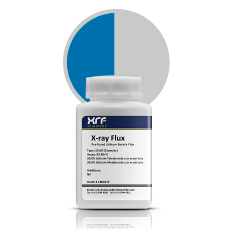Lithium Tetraborate X-ray Flux for Alumina Fusion
Determining the volume of aluminium oxide (Al2O3), or alumina, in clays and silicates can be an arduous task. Gravimetric analysis has been classically applied, but these techniques are both time-consuming and complicated. Samples must first be decomposed using a choice of precipitants before aluminium is separated from interfering elements like iron (Fe) and titanium (Ti). The precipitate is fired to promote oxidation then weighed. This may be expressed as a percentile of overall sample weight or as alumina after ignition.
Why Use X-ray Flux Chemicals for Alumina Fusion?
Various organic reagents are proposed for quantitative precipitation of aluminium, which creates a burden of choice. Additionally, the gravimetric workflow itself is a lengthy and inefficient process.

A novel approach to alumina quantitation in siliceous materials like bauxite ore is fusion using X-ray flux chemicals like lithium borate salts such as lithium tetraborate or metaborate. Preparing siliceous samples as homogenous glass beads or discs allows geochemists to rapidly determine the elemental fingerprint of clays/rocks down to the sub-parts per million (ppm) range. Assessing alumina content via spectral analysis is far more precise than gravimetry, and enables streamlined workflows with greater degrees of repeatability.
However, it is important to select the right X-ray flux chemicals for the sample. Lithium fusion is a good general purpose approach to decomposing geological sample matrices. Yet high-temperature chemical interactions can be punishing to samples, as well as contributing to labware degradation. Hence the importance of selecting the right flux.
Which Lithium Tetraborate Fluxes are Suitable for Alumina?
Lithium tetraborate (Li2B4O7) is the most commonly used flux chemical for X-ray fluorescence (XRF) and inductively-coupled plasma mass spectroscopy (ICP-MS). It is transparent to light element X-rays, meaning it does not interfere with key spectral analyses. Yet it has a relatively high melting point (930C), which makes it difficult to fuse with some ores (i.e. bauxite). Often it is best to use a mixture of lithium tetraborate flux with lithium metaborate (LiBO2) which has a lower melting point (849C) and generally better solubility.
At XRF Scientific, we recommend a mixture of lithium tetraborate and metaborate at ratios of 50:50. This makes an ideal general purpose flux with excellent fusion compatibility for neutral samples. Our 50:50 lithium tetraborate/lithium metaborate mixture is perfect for alumina fusion and promotes rapid matrix decomposition with low loss on ignition (LOI).
Interested in using lithium tetraborate X-ray flux chemicals for alumina samples? Contact a member of the XRF Scientific team today.









